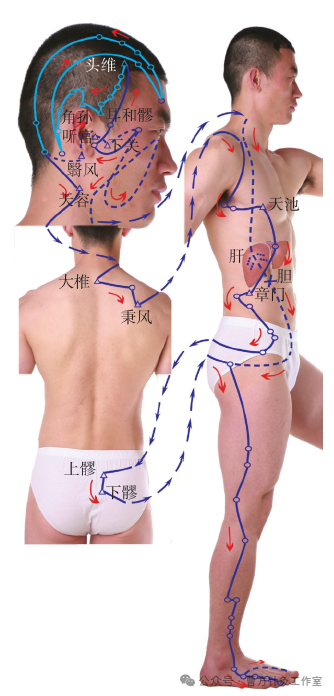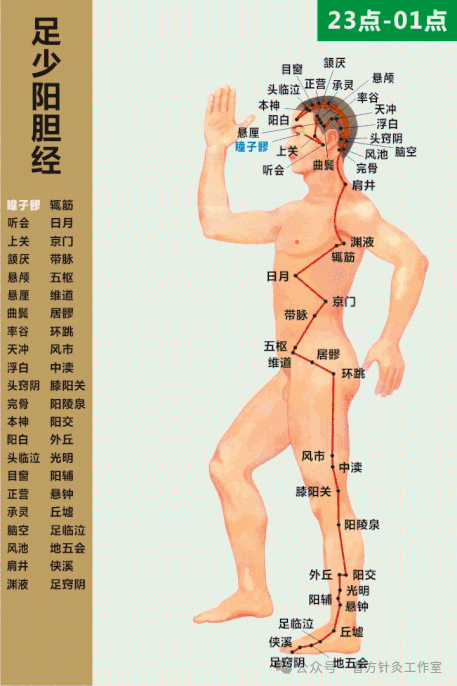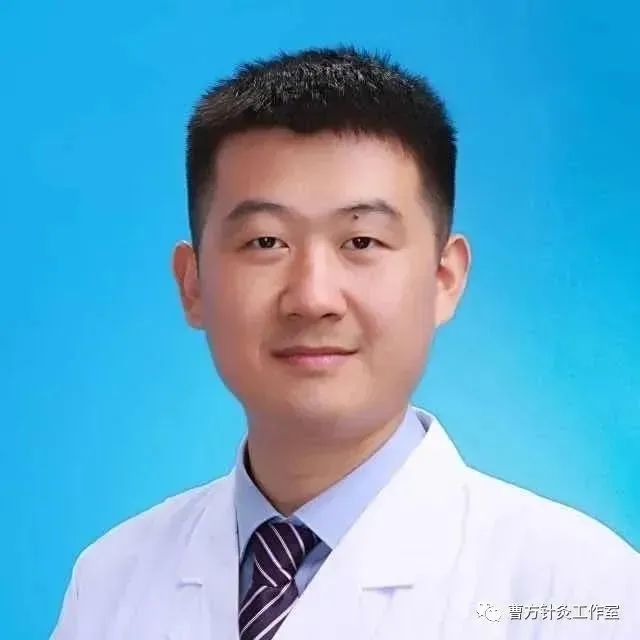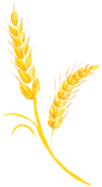
Overview of the Foot Shao Yang Gallbladder Meridian
The Foot Shao Yang Gallbladder Meridian connects at the outer canthus of the eye with the Hand Shao Yang Sanjiao Meridian, linking to the organs of the eyes and ears, associated with the gallbladder and liver, and connects with the Foot Jue Yin Liver Meridian behind the toenail of the big toe.
The collaterals run from Guangming to the dorsum of the foot.
The branches penetrate the heart, connect to the throat, spread to the face, and link to the eyes.
The muscle pathways terminate at the buttocks, connect to the chest and breast, intersect at the vertex, and cross each other laterally, forming interconnections.

Pathway of the Collaterals


Original Text
The branch of the Foot Shao Yang, named Guangming, is located five cun above the outer ankle, diverging to the Jue Yin, and connecting to the foot tarsals.
If excess, it leads to coldness in the foot; if deficient, it results in weakness and inability to rise. This is where it diverges.
— from Ling Shu · Meridians




Interpretation
The collateral of the Foot Shao Yang, named Guangming, diverges five cun above the outer ankle, connecting to the Jue Yin meridian, and links downward to the dorsum of the foot.If there is excess, coldness in the foot is observed; if there is deficiency, weakness in the lower limbs, limping, or falling, and inability to stand can be seen. The Foot Shao Yang collateral point can be used for treatment.
Pathway of the Branches


Original Text
The main branch of the Foot Shao Yang encircles the hip, enters the hairline, connects to the Jue Yin; the diverging branch enters between the ribs, traverses the chest, belongs to the gallbladder, disperses to the liver, penetrates the heart, and ascends to the throat, emerging at the jaw, dispersing to the face, linking to the eyes, and connecting the Shao Yang at the outer canthus.
— from Ling Shu · Branches



Interpretation
The branch of the Foot Shao Yang diverges from the Foot Shao Yang Gallbladder Meridian, encircling the front of the thigh, entering the external genitalia, and meeting with the Foot Jue Yin branch; it branches into the floating ribs. It traverses the thoracic cavity, belongs to the gallbladder, disperses to the liver, penetrates the heart, and connects to the esophagus and throat, emerging at the jaw, dispersing to the face, linking to the eyes at the outer canthus, where it meets the Foot Shao Yang meridian.
Pathway of the Muscle Pathways


Original Text
The muscle pathway of the Foot Shao Yang begins at the second toe, connects to the outer ankle; it ascends along the outer edge of the tibia, terminating at the outer side of the knee.
The branch diverges from the outer fibula, ascends to the hip, with the anterior branch terminating above the knee, and the posterior branch terminating at the buttocks.
The direct pathway ascends to the axilla, traverses the chest, connects to the breast, and terminates at the supraclavicular fossa. The direct pathway ascends from the axilla, penetrates the supraclavicular fossa, emerges before the Tai Yang, traverses behind the ear, ascends to the forehead, intersects at the vertex, descends to the jaw, and terminates at the chin. The branch terminates at the outer canthus of the eye, forming the “outer connection”.
The conditions: The second toe may experience stiffness, leading to pain in the outer knee, making it difficult to flex or extend the knee, with tightness in the hamstrings, pulling the hip forward and the buttocks backward, causing pain in the lower ribs and the area below the ribs, pulling up to the supraclavicular fossa, breast, and neck, resulting in tightness in the connecting muscles. If the left side is tight, the right eye may not open. This is because this pathway crosses the right forehead and runs parallel to the Yang Qiao Meridian, where the Yin and Yang Qiao Meridians intersect, and the left and right pathways also intersect, causing injury to the left forehead to affect the right foot, termed intersecting muscles.
— from Ling Shu · Muscle Pathways



Interpretation
The muscle pathway of the Foot Shao Yang runs along the fourth toe, connecting to the outer ankle, then ascends along the outer side of the tibia to the outer side of the knee. Its branch diverges from the fibula, ascending along the outer thigh, with the anterior branch terminating at the quadriceps (vastus lateralis), and the posterior branch terminating at the sacral region. The direct pathway ascends to the lateral side of the ribs, traverses the axilla, connecting to the chest and breast, terminating at the supraclavicular fossa. The direct pathway ascends from the axilla, penetrates the supraclavicular fossa, moves toward the front of the Tai Yang, traverses behind the ear, ascends to the forehead, intersects at the vertex, and descends to the neck, terminating at the side of the nose. The branch terminates at the outer canthus of the eye, forming the “outer connection”.The symptoms: Stiffness and discomfort may be observed in the fourth toe, leading to pain in the outer knee, making it difficult to flex or extend the knee, with tightness in the hamstrings, pulling the hip forward and the buttocks backward, causing pain in the lower ribs and the area below the ribs, pulling up to the supraclavicular fossa, breast, and neck, resulting in tightness in the connecting muscles.If the left side is tight, the right eye may not open. This is because this pathway crosses the right forehead and runs parallel to the Yang Qiao Meridian, where the Yin and Yang Qiao Meridians intersect, and the left and right pathways also intersect, causing injury to the left forehead to affect the right foot, termed intersecting muscles.
Note: Content sourced from Study of Meridians and Acupoints (National Planning Textbook for Higher Education, Chinese Medicine Press), Study of Meridians and Acupoints (National Planning Textbook for Higher Education in Traditional Chinese Medicine, Chinese Medicine Press), Acupuncture (Advanced Series in Traditional Chinese Medicine, People’s Health Publishing House)
Previous Recommendations:
Meridians and Acupoints | Tongzi Liao: Brightening the Eyes, Reducing Opacity, Calming the Liver and Extinguishing Wind
Meridians and Acupoints | Tinghui: Opening the Orifices, Enhancing Hearing, Unblocking Meridians
Meridians and Acupoints | Shuai Gu: Calming the Liver and Extinguishing Wind, Settling the Spirit and Stopping Vomiting
Meridians and Acupoints | Qu Bian: Dispelling Wind and Stopping Pain, Opening and Unblocking Orifices
Meridians and Acupoints | Foot Shao Yang Gallbladder Meridian: ① Pathway of the Meridian, ② Symptoms of the Meridian

Dr. Cao’s Acupuncture Studio says:

“Acupuncture regulates the qi and blood of the meridians, adjusts the yin and yang of the organs, supplements deficiency and drains excess, achieving a beneficial regulation of the body. Clinical acupuncture distinguishes the nature of diseases, emphasizes a holistic view, applies the three causes appropriately, selects points accurately, and employs suitable techniques, thus treating various ailments.”


Dr. Cao Fang

Attending physician in the Department of Traditional Therapy at the First Affiliated Hospital of Henan University of Chinese Medicine, graduated from Changchun University of Chinese Medicine with a major in Acupuncture and Tuina, expert in health education for provincial cadres in Henan, recipient of the “Good Person of Jilin” award, member of the Acupuncture Literature Committee of the Chinese Acupuncture Society, member of the Evidence-Based Acupuncture Committee of the Chinese Acupuncture Society, member of the Chinese Science Writers Association, youth member of the Science Popularization Branch of the Chinese Association of Traditional Chinese Medicine, director of the Intangible Cultural Heritage Protection Branch of the Chinese Ethnic Medicine Association, executive member of the Health and Elderly Care Industry Branch of the Henan Rehabilitation Medicine Association, part-time teacher at Henan University for the Elderly, editorial board member and reviewer for Chinese Health Preservation, Chinese General Practice, Chinese Journal of Basic Traditional Chinese Medicine, Chinese Folk Therapy, and special reviewer for Chinese Acupuncture Electronic Journal.
Has hosted and participated in 29 national and provincial research projects, published 22 papers as the first (corresponding) author in SCI-indexed and core journals, co-editor and contributor to 15 academic works, and authored over 70 popular science articles in China Traditional Chinese Medicine News.
Has received the second prize of the Scientific and Technological Achievement Award from the Chinese Acupuncture Society, the second prize for excellent scientific papers from the Henan Provincial Department of Education in 2024, the first prize for health science popularization works in the sixth Henan Health Science Popularization Skills Competition, and delivered a course on common diseases in the elderly titled “Traditional Chinese Medicine Health Preservation for the Elderly,” which was recognized as a distinctive video course in the 11th batch of national remote education for the elderly.

Clinical
Expertise
Specializes
in
allergic diseases (rhinitis, stubborn eczema, recurrent urticaria, etc.), myopia in children and adolescents, adenoid hypertrophy, stubborn insomnia, persistent migraines, anxiety and depression, stubborn facial paralysis, tinnitus and hearing loss, polycystic ovary syndrome, dysmenorrhea and other gynecological diseases, neck, shoulder, waist, and leg pain, trigeminal neuralgia, shingles, chronic prostatitis, constipation, hypertension, post-stroke sequelae, spleen and stomach diseases (chronic gastritis, bloating, irritable bowel syndrome, chronic diarrhea, indigestion, gastric ptosis), and sub-health conditioning through traditional Chinese medicine therapies.
Consultation
Schedule
Tuesday, Friday, Saturday mornings
Wednesday and Thursday evenings (6 PM – 8 PM)
Consultation
Location
People’s Road Hospital Area, Outpatient Building A, 8th Floor, Room 9
Online
Appointment
Follow the official WeChat account of “First Affiliated Hospital of Henan University of Chinese Medicine”
Select “Traditional Therapy Department” (Tuesday, Friday, Saturday mornings) or “Evening Outpatient” (Wednesday, Thursday) — “Cao Fang”, to make an appointment for consultation.
Produced by: Cao Fang Acupuncture Studio Edited by: Shi Zhonghan, Zhang Yueqian Reviewed by: Cao Fang

